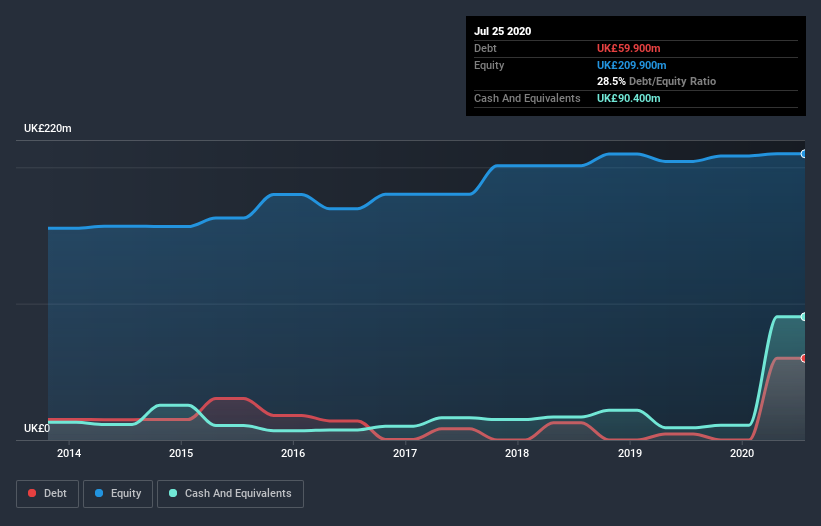A.G. BARR (LON:BAG) Has A Rock Solid Balance Sheet

Howard Marks put it nicely when he said that, rather than worrying about share price volatility, 'The possibility of permanent loss is the risk I worry about... and every practical investor I know worries about.' It's only natural to consider a company's balance sheet when you examine how risky it is, since debt is often involved when a business collapses. We note that A.G. BARR p.l.c. (LON:BAG) does have debt on its balance sheet. But the more important question is: how much risk is that debt creating?
What Risk Does Debt Bring?
Debt and other liabilities become risky for a business when it cannot easily fulfill those obligations, either with free cash flow or by raising capital at an attractive price. If things get really bad, the lenders can take control of the business. However, a more usual (but still expensive) situation is where a company must dilute shareholders at a cheap share price simply to get debt under control. Of course, debt can be an important tool in businesses, particularly capital heavy businesses. The first thing to do when considering how much debt a business uses is to look at its cash and debt together.
See our latest analysis for A.G. BARR
What Is A.G. BARR's Debt?
You can click the graphic below for the historical numbers, but it shows that as of July 2020 A.G. BARR had UK£59.9m of debt, an increase on UK£4.40m, over one year. However, its balance sheet shows it holds UK£90.4m in cash, so it actually has UK£30.5m net cash.
A Look At A.G. BARR's Liabilities
We can see from the most recent balance sheet that A.G. BARR had liabilities of UK£122.8m falling due within a year, and liabilities of UK£27.8m due beyond that. Offsetting these obligations, it had cash of UK£90.4m as well as receivables valued at UK£54.7m due within 12 months. So its liabilities outweigh the sum of its cash and (near-term) receivables by UK£5.50m.
Having regard to A.G. BARR's size, it seems that its liquid assets are well balanced with its total liabilities. So it's very unlikely that the UK£530.8m company is short on cash, but still worth keeping an eye on the balance sheet. Despite its noteworthy liabilities, A.G. BARR boasts net cash, so it's fair to say it does not have a heavy debt load!
A.G. BARR's EBIT was pretty flat over the last year, but that shouldn't be an issue given the it doesn't have a lot of debt. When analysing debt levels, the balance sheet is the obvious place to start. But it is future earnings, more than anything, that will determine A.G. BARR's ability to maintain a healthy balance sheet going forward. So if you're focused on the future you can check out this free report showing analyst profit forecasts.
Finally, a company can only pay off debt with cold hard cash, not accounting profits. A.G. BARR may have net cash on the balance sheet, but it is still interesting to look at how well the business converts its earnings before interest and tax (EBIT) to free cash flow, because that will influence both its need for, and its capacity to manage debt. During the last three years, A.G. BARR generated free cash flow amounting to a very robust 80% of its EBIT, more than we'd expect. That positions it well to pay down debt if desirable to do so.
Summing up
While it is always sensible to look at a company's total liabilities, it is very reassuring that A.G. BARR has UK£30.5m in net cash. And it impressed us with free cash flow of UK£43m, being 80% of its EBIT. So we don't think A.G. BARR's use of debt is risky. There's no doubt that we learn most about debt from the balance sheet. But ultimately, every company can contain risks that exist outside of the balance sheet. For example, we've discovered 2 warning signs for A.G. BARR that you should be aware of before investing here.
If, after all that, you're more interested in a fast growing company with a rock-solid balance sheet, then check out our list of net cash growth stocks without delay.
This article by Simply Wall St is general in nature. It does not constitute a recommendation to buy or sell any stock, and does not take account of your objectives, or your financial situation. We aim to bring you long-term focused analysis driven by fundamental data. Note that our analysis may not factor in the latest price-sensitive company announcements or qualitative material. Simply Wall St has no position in any stocks mentioned.
Have feedback on this article? Concerned about the content? Get in touch with us directly. Alternatively, email editorial-team@simplywallst.com.

 Yahoo News
Yahoo News 

